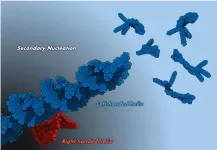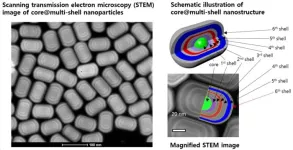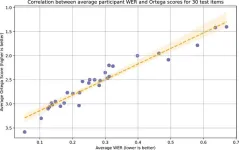(Press-News.org) Although we know that supermassive black holes (millions of times the mass of our Sun) lurk at the centre of most galaxies, their very nature makes them difficult to spot and study. In contrast to the popular idea of black holes constantly ‘gobbling up’ matter, these gravitational monsters can spend long periods of time in a dormant, inactive phase.
This was true of the black hole at the heart of SDSS1335+0728, a distant and unremarkable galaxy 300 million light-years away in the constellation of Virgo. After being inactive for decades, it suddenly lit up and recently began producing unprecedented flashes of X-ray light.
The first signs of activity appeared in late 2019, when the galaxy unexpectedly began shining brightly, attracting the attention of astronomers. After studying it for several years, they concluded that the unusual changes they saw were probably the result of the black hole suddenly ‘switching on’ – entering an active phase. The bright, compact, central region of the galaxy is now classified as an active galactic nucleus, nicknamed ‘Ansky’.
“When we first saw Ansky light up in optical images, we triggered follow-up observations using NASA’s Swift X-ray space telescope, and we checked archived data from the eROSITA X-ray telescope, but at the time we didn’t see any evidence of X-ray emissions,” says Paula Sánchez Sáez, a researcher at the European Southern Observatory, Germany, and leader of the team that first explored the black hole’s activation.
Ansky wakes up
Then, in February 2024, a team led by Lorena Hernández-García, a researcher at the Valparaiso University, Chile, began to see bursts of X-rays from Ansky at nearly regular intervals.
“This rare event provides an opportunity for astronomers to observe a black hole’s behaviour in real time, using X-ray space telescopes XMM-Newton and NASA’s NICER, Chandra and Swift. This phenomenon is known as a quasiperiodic eruption, or QPE. QPEs are short-lived flaring events. And this is the first time we have observed such an event in a black hole that seems to be waking up,” explains Lorena.
“The first QPE episode was discovered in 2019, and since then we’ve only detected a handful more. We don’t yet understand what causes them. Studying Ansky will help us to better understand black holes and how they evolve.”
“XMM-Newton played a pivotal role in our study. It is the only X-ray telescope sensitive enough to detect the fainter X-ray background light between the bursts. With XMM-Newton we could measure how dim Ansky gets, which enabled us to calculate how much energy Ansky releases when it lights up and starts flashing.”
Unravelling puzzling behaviour
The gravity of a black hole captures matter that gets too close and can rip it apart. The matter from a captured star, for example, would be spread into a hot, bright, rapidly spinning disc called an accretion disc. Current thinking is that QPEs are caused by an object (that could be a star or a small black hole) interacting with this accretion disc and they have been linked to the destruction of a star. But there is no evidence that Ansky has destroyed a star.
The extraordinary characteristics of Ansky’s recurring bursts prompted the research team to consider other possibilities. The accretion disc could be formed by gas captured by the black hole from its neighbourhood, and not a disintegrated star. In this scenario, the X-ray flares would be coming from highly energetic shocks in the disc, provoked by a small celestial object travelling through and disrupting the orbiting material, repeatedly.
“The bursts of X-rays from Ansky are ten times longer and ten times more luminous than what we see from a typical QPE,” says Joheen Chakraborty, a team member and PhD student at the Massachusetts Institute of Technology, USA.
“Each of these eruptions is releasing a hundred times more energy than we have seen elsewhere. Ansky’s eruptions also show the longest cadence ever observed, of about 4.5 days. This pushes our models to their limits and challenges our existing ideas about how these X-ray flashes are being generated.”
Watching a black hole in action
Being able to watch Ansky evolving in real time is an unprecedented opportunity for astronomers to learn more about black holes and the energetic events they power.
“For QPEs, we’re still at the point where we have more models than data, and we need more observations to understand what's happening,” says ESA Research Fellow and X-ray astronomer, Erwan Quintin.
“We thought that QPEs were the result of small celestial objects being captured by much larger ones and spiralling down towards them. Ansky’s eruptions seem to be telling us a different story. These repetitive bursts are also likely associated with gravitational waves that ESA’s future mission LISA might be able to catch.”
“It’s crucial to have these X-ray observations that will complement the gravitational wave data and help us solve the puzzling behaviour of massive black holes.”
END
From boring to bursting: a giant black hole awakens
2025-04-11
ELSE PRESS RELEASES FROM THIS DATE:
Illuminating the twist: light-driven inversion of supramolecular chirality
2025-04-11
Self-assembly or self-organization in molecular science refers to the phenomena where molecules spontaneously gather and form ordered structures, a unique property of materials used to develop optical and electronic materials. In a step towards fine-tuning this property, researchers from Japan successfully elucidated a technique where a small amount of residual aggregates drastically altered the self-assembly process of photo-responsive molecules. The research team was led by Professor Shiki Yagai from the Graduate School of Engineering, Chiba University, including Assistant Professor ...
Engineered bacteria emit signals that can be spotted from a distance
2025-04-11
CAMBRIDGE, MA -- Bacteria can be engineered to sense a variety of molecules, such as pollutants or soil nutrients. In most cases, however, these signals can only be detected by looking at the cells under a microscope or similarly sensitive lab equipment, making them impractical for large-scale use.
Using a new method that triggers cells to produce molecules that generate unique combinations of color, MIT engineers have shown that they can read out these bacterial signals from as far as 90 meters away. Their work could lead to the development of bacterial sensors for agricultural and other applications, which could be monitored by drones or ...
Scalable graphene membranes: a leap for carbon capture
2025-04-11
Capturing carbon dioxide (CO₂) from industrial emissions is crucial in the fight against climate change. But current methods, like chemical absorption, are expensive and energy-intensive. Scientists have long eyed graphene—an atom-thin, ultra-strong material—as a promising alternative for gas separation, but making large-area, efficient graphene membranes has been a challenge.
Now, a team at EPFL, led by Professor Kumar Agrawal, has developed a scalable technique to create porous graphene membranes ...
Early detection of Parkinson’s with novel RNA-based blood test
2025-04-11
Researchers have developed a simple and cost-effective blood test capable of detecting Parkinson’s disease long before symptoms emerge, comparing the current state of diagnosing neurodegenerative diseases to the fight against cancer 50 years ago—when most cases were identified too late for effective treatment. The test quantifies specific RNA fragments in the blood, focusing on a repetitive RNA sequence that accumulates in Parkinson’s patients and a parallel decline in mitochondrial RNA, which deteriorates as the disease progresses. By measuring the ratio between these biomarkers, the test offers a highly accurate, non-invasive, rapid and affordable diagnostic tool, ...
“Internet of nature” helps researchers explore the web of life
2025-04-11
A novel paper led by Dr Ulrich Brose of the German Centre for Integrative Biodiversity Research (iDiv) and the Friedrich Schiller University Jena is widening understanding of how species interact within ecosystems via the so-called “Internet of Nature.” Published in Nature Ecology and Evolution, the paper reveals that species not only exchange matter and energy but also share vital information that influences behaviour, interactions, and ecosystem dynamics – revealing previously hidden characteristics of natural ecosystems.
Traditionally, ecological studies have ...
Police officers face twice the risk of traumatic brain injuries and PTSD, survey finds
2025-04-11
Police officers are more than twice as likely to have traumatic brain injuries compared to the general population. Officers who incur these injuries while on duty face more than double the risk of developing complex post-traumatic stress disorder (PTSD).
That’s according to a new survey-based study from the University of Exeter, published in The Journal of Head Trauma Rehabilitation, which found a connection between traumatic brain injuries and PTSD in police officers. Authors say the findings ...
Patrick Tan appointed as Duke-NUS Dean to lead next era of medical innovation and education
2025-04-11
SINGAPORE, 11 APRIL 2025—Duke-NUS Medical School has appointed Professor Patrick Tan as its next and fourth Dean, effective 1 January 2026, marking a new chapter for the School as it builds on its legacy of medical education, research and innovation. Prof Tan will serve as Dean-designate from 1 July 2025, succeeding Professor Thomas Coffman, the School’s longest-serving Dean since 2015. This leadership transition coincides with the School’s 20th anniversary, underscoring Duke-NUS’ commitment to advancing ...
Development of a novel modified selective medium cefixime–tellurite-phosphate-xylose-rhamnose MacConkey agar for isolation of Escherichia albertii and its evaluation with food samples
2025-04-11
Since cefixime and tellurite are known to inhibit most bacteria belonging to Enterobacterales, we found that addition of tellurite inhibited E. albertii growth in Luria Bertani broth but not in tryptic soy broth (TSB), and addition of phosphate and soy peptone enhanced E. albertii growth in TSB in presence of tellurite.
Subsequently, to find the positive factor present in TSB, E. albertii growth was examined in tryptone, soy peptone, glucose, or phosphate deficient tryptic soy agar plates. Phosphate, soy peptone, and/or ...
KIST develops full-color-emitting upconversion nanoparticle technology for color displays with ultra-high color reproducibility
2025-04-11
Dr. Ho Seong Jang and colleagues at the Extreme Materials Research Center at the Korea Institute of Science and Technology (KIST) have developed an upconversion nanoparticle technology that introduces a core@multi-shell nanostructure, a multilayer structure in which multiple layers of shells surround a central core particle, and enables high color purity RGB light emission from a single nanoparticle by adjusting the infrared wavelength.
Luminescent materials are materials that light up on their own and are used in a variety of display devices, including TVs, tablets, monitors, and smartphones, to allow us to view a variety of images ...
Towards a fully automated approach for assessing English proficiency
2025-04-11
In today’s increasingly interconnected world, language learning has become essential for education, business, and cultural exchange. However, accurately measuring proficiency in language learners is a complex matter. One particularly valuable approach involves asking learners to listen to sentences and then repeat them back as accurately as possible. Known as elicited imitation (EI), this method reveals much more than mere memory and mimicking abilities. When sentences exceed our working memory capacity—typically beyond 8 to 10 syllables—successful repetition requires learners to quickly process and ...





